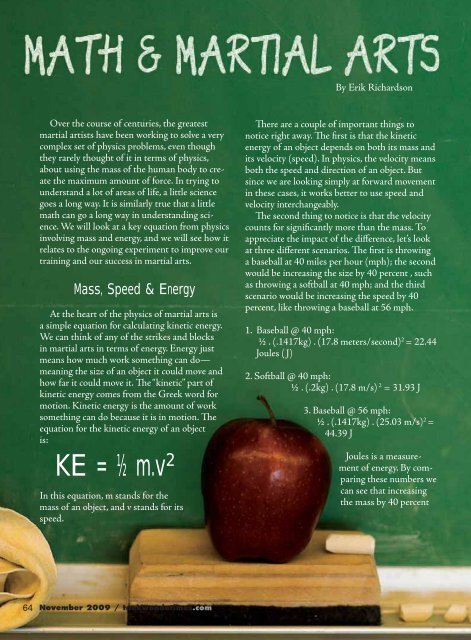Grandmaster Ken MacKenzie - Taekwondo Times
Grandmaster Ken MacKenzie - Taekwondo Times
Grandmaster Ken MacKenzie - Taekwondo Times
Create successful ePaper yourself
Turn your PDF publications into a flip-book with our unique Google optimized e-Paper software.
By Erik Richardson<br />
Over the course of centuries, the greatest<br />
martial artists have been working to solve a very<br />
complex set of physics problems, even though<br />
they rarely thought of it in terms of physics,<br />
about using the mass of the human body to create<br />
the maximum amount of force. In trying to<br />
understand a lot of areas of life, a little science<br />
goes a long way. It is similarly true that a little<br />
math can go a long way in understanding science.<br />
We will look at a key equation from physics<br />
involving mass and energy, and we will see how it<br />
relates to the ongoing experiment to improve our<br />
training and our success in martial arts.<br />
Mass, Speed & Energy<br />
At the heart of the physics of martial arts is<br />
a simple equation for calculating kinetic energy.<br />
We can think of any of the strikes and blocks<br />
in martial arts in terms of energy. Energy just<br />
means how much work something can do—<br />
meaning the size of an object it could move and<br />
how far it could move it. The “kinetic” part of<br />
kinetic energy comes from the Greek word for<br />
motion. Kinetic energy is the amount of work<br />
something can do because it is in motion. The<br />
equation for the kinetic energy of an object<br />
is:<br />
KE = ½ m.v 2<br />
In this equation, m stands for the<br />
mass of an object, and v stands for its<br />
speed.<br />
There are a couple of important things to<br />
notice right away. The first is that the kinetic<br />
energy of an object depends on both its mass and<br />
its velocity (speed). In physics, the velocity means<br />
both the speed and direction of an object. But<br />
since we are looking simply at forward movement<br />
in these cases, it works better to use speed and<br />
velocity interchangeably.<br />
The second thing to notice is that the velocity<br />
counts for significantly more than the mass. To<br />
appreciate the impact of the difference, let’s look<br />
at three different scenarios. The first is throwing<br />
a baseball at 40 miles per hour (mph); the second<br />
would be increasing the size by 40 percent , such<br />
as throwing a softball at 40 mph; and the third<br />
scenario would be increasing the speed by 40<br />
percent, like throwing a baseball at 56 mph.<br />
1. Baseball @ 40 mph:<br />
½ . (.1417kg) . (17.8 meters/second) 2 = 22.44<br />
Joules ( J)<br />
2. Softball @ 40 mph:<br />
½ . (.2kg) . (17.8 m/s) 2 = 31.93 J<br />
3. Baseball @ 56 mph:<br />
½ . (.1417kg) . (25.03 m/s) 2 =<br />
44.39 J<br />
Joules is a measurement<br />
of energy. By comparing<br />
these numbers we<br />
can see that increasing<br />
the mass by 40 percent<br />
64 November 2009 / taekwondotimes.com













